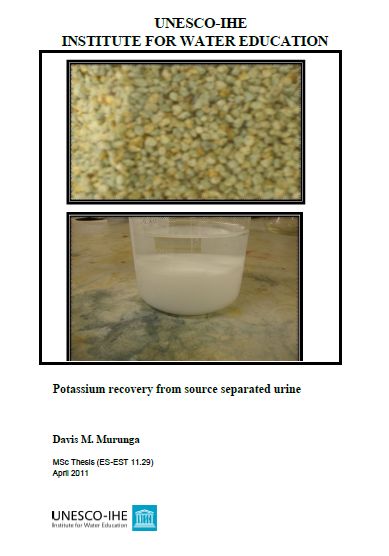
Published in: 2011
Publisher:
MSc Thesis, UNESCO-IHE Institute for Water Education, Delft, The Netherlands
Author:
Murunga, D.
Uploaded by:
SuSanA secretariat
Partner profile:
IHE Delft Institute for Water Education
7408 Views
120 Downloads
Content - Summary
Potassium is a significant natural resource required by plants and animals. Its extraction has possible adverse environmental effects. Human urine is a key potassium source and source separation could significantly improve waste water effluent quality. In domestic waste water, potassium is 60% of urine.
The main objective was to determine the potassium recovery potential from recipes of artificial human urine that is assumed to have undergone four treatment processes, namely; hydrolysis, sharon-anammox, nitrification and struvite precipitation.
This was achieved through use of two techniques; adsorption and precipitation. Zeolites were used as adsorbents in each of the solutions from the four treatment processes. For precipitation experiments, magnesium and potassium were added in equal ratios to potassium in the respective solution in order to precipitate potassium struvite. The precipitation experiments were also simulated by PHREEQC (Version 2) model to determine the key species involved in each of the treatment stream during precipitation process.
In precipitation, the sharon-anammox stream gave the overall highest recovery of potassium, with at least 55% recovery for all its sub-stream experiments. The struvite and hydrolysis streams gave the lowest potassium recovery, with hydrolysis stream having an average of 44% while struvite had an average of 46%.
Similarly, in adsorption experiments, sharon-anammox stream had the best output. Using Langmuir adsorption model in experiment 3, it had an equilibrium adsorption constant (b) value of 72.22 litres per gram, with monolayer adsorption capacity (qm) of 0.0086 grams per gram of zeolite (R2=0.703).More so, with Freundlich model the stream it had an adsorption capacity (K) of 0.0095(R2= 0.63).The value of the Freundlich parameter, n which was computed as 7.41 was found to be between 1 and 10 which indicates a favourable adsorption.
Bibliographic information
Murunga, D. (2011). Potassium recovery from source separated urine. MSc Thesis, UNESCO-IHE Institute for Water Education, Delft, The Netherlands
Filter tags
English Fertiliser Urine















